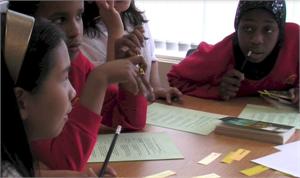
Pupils learning English as an additional language (EAL) share many common characteristics with pupils whose first language is English. Many of their learning needs are similar to those of other children and young people learning in our schools. However, these pupils also have distinct and different needs from other pupils by virtue of the fact that they are learning in and through another language, and that they come from cultural backgrounds and communities with different understandings and expectations of education, language and learning.
A number of factors will have an impact on the development of pupils' language skills and their ability to apply these skills to their learning across the curriculum:
- the age at which pupils enter the educational system
- their previous experience of schooling and literacy in their first language;
- their knowledge, skills and understanding of languages and the school curriculum;
- home and community expectations and understanding of the education system;
- support structures for learning and language development at home and at school
Pupils with English as an additional language are not a homogeneous group. Teachers and educational policy makers need to be aware of the range of variables in relation to both individual learners and groups. These variables will also be significant when interpreting the overall task which learning EAL entails.
- Some pupils are born in the UK but enter school speaking little or no English and have limited or no experience of literacy in their first language.
- Some pupils are born in the UK but enter school speaking little or no English. However, they have some experience of literacy in their first languages.
- Some pupils arrive between the ages of 5 and 16 without literacy or oracy skills in English but with age equivalent skills in literacy and oracy in their first languages, and sometimes in other languages as well.
- Some pupils enter the school system between the ages of 5 and 16 withoutliteracy or oracy skills in English and with limited or no literacy skills in their first language due to disrupted schooling.
- In addition, some pupils have suffered emotional and psychological stress as a result of family loss or social and economic disruption to their lives in their countries of origin.
What can we say about pupils learning EAL in our schools?
Learners may:
- have varied cultural, social and economic backgrounds;
- have varying levels and kinds of school experience;
- have different expectations of schooling and education;
- have had disrupted or little formal education;
- have had varying previous exposure to English;
- be born in the UK, arrive before formal schooling begins or arrive later;
- come from established or new communities;
- be isolated, refugees or be with other members of the same language/cultural/ethnic group;
- experience or have experienced racism, emotional or psychological stress, mental or physical ill health.
Learners may:
- speak and read and/or write different languages for different purposes;
- have knowledge of more than one language system;
- be literate in one or more languages;
- have little or no knowledge of the Roman script;
- feel positive, negative, confident, or sensitive about their other languages;
- make links between prior learning and new learning.
Learners may:
- be at different stages in terms of English language proficiency;
- have acquired other languages before beginning to acquire English;
- have begun to acquire another language prior to acquiring English;
- be learning another language at the same time as learning English.
Learners will be using English:
- to communicate socially;
- to construct relationships;
- to understand systems and procedures (including the cultural rules of the classroom and school life);
- to develop conceptual knowledge;
- to construct and explore ideas;
- to make links with prior learning;
- to access other learning across the curriculum;
- to negotiate meaning.
Learners differ in terms of:
- motivation;
- home support and facilities;
- perceptions of themselves as learners;
- learning styles.
Pupil learning will be influenced by:
- the school's knowledge and understanding of their previous experience and learning;
- the school's policy and practice for race equality;
- teachers' knowledge and understanding of second / additional language development;
- teachers' ability to assess individual needs and plan for individual language learning;
- teachers' ability to integrate the teaching of language and curriculum content;
- teachers' ability to motivate pupils and support the lengthy process of second/additional language learning.
Both within and across communities there will be different understandings of:
- the purposes of education;
- what constitutes literacy;
- the role of parents in relation to education;
- the role of the school;
- home / school relationships.
Teachers and educational policy makers need to be aware of the range of variables outlines here in relation to both individual learners and groups. These variables will also be significant when interpreting the overall task which learning EAL entails.
Adapted from Working Paper 5: The Distinctiveness of EAL: A Cross-Curriculum Discipline. (1999) Watford : NALDIC
Editor
Nicola Davies
Last updated
January 2012